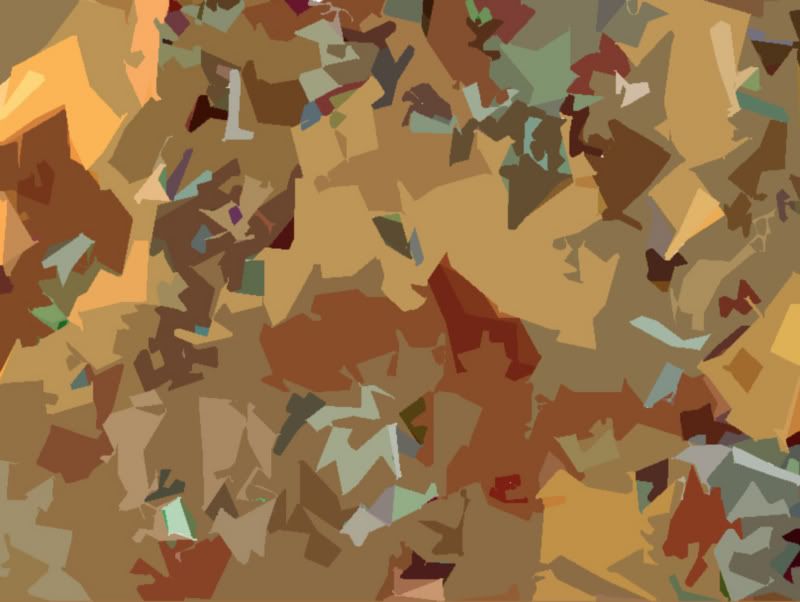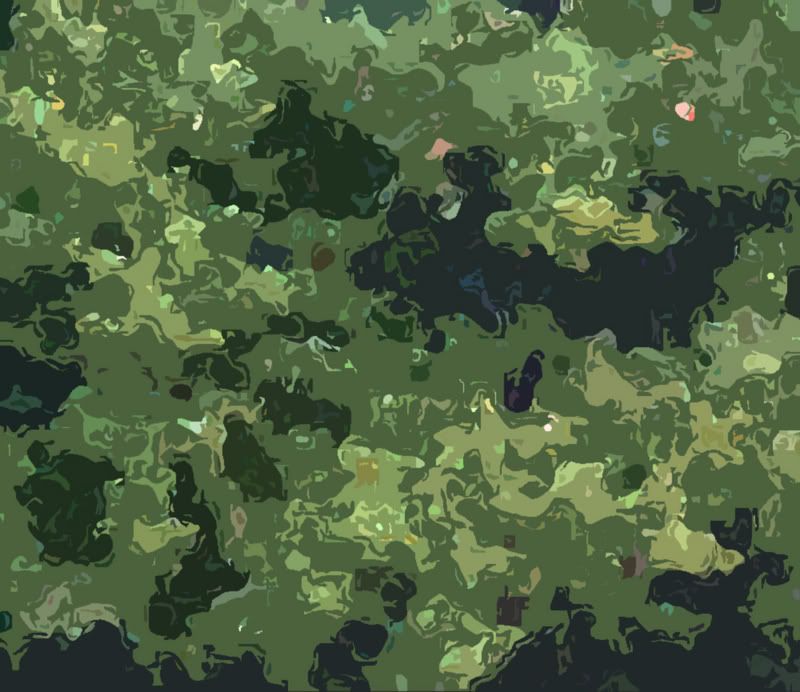This is a repost of an article I wrote a year or so ago, many of it's main ideas were hit on earlier in the thread. It's about the use of Camouflage for stealth camping. . .
http://www.gnn.tv/B10394
Camouflage is one topic that is seldom covered in backpacking manuals, simply because hiking down the Appalachian Trail does not require you to sneak. However, if you are going to be walking any considerable distance without trails, you will find yourself crossing many right-of-ways and being forced to camp in locations where you are not wanted. Thus, camouflage is an essential task for any Guerilla Camper.
Camouflage is also a matter of courtesy and I wish more traditional hikers would begin to utilize it. While every hiking book talks about âleaving no traceâ, is seems no one has considered âhaving no traceâ of any importance to campers. It seems every tent out there is safety orange, fire engine red, sky blue or a combination of all three and few things bother me more than finding a hidden spot overlooking a gorgeous meadow, only to watch some guy set up his signal flag tent in the middle of the vista. Please, be inconspicuous, if only to not annoy me.
There are two parts to successful camouflage, equipment and action. Equipment is something best handled at home. Before âmovingâ, which often entails lots of sidewalk hiking and dubiously legal camping, I take the time to check all my gear. This allows me to inventory as well as check for damage and wear.
I begin with a small bottle of acrylic paint and a can of cheap, flat black spray paint and start by unpacking everything and laying it out as neatly as possible. I start with my pack, using the acrylic paint to paint buttons, slides, snaps on the pack and scratches on the frame. An excellent paint for this purpose is sold as surplus stores as M-Nu. If the frame is too scratched, I will take it outside and repaint it with the spray paint. I then repeat this with my ponchos, my hammock, my coats and my shoes. Eyelets, guy hooks and anything else shiny gets painted over. I then take my tent stakes and give them two coats of spray paint. This does not last long, but the only goal is to eliminate shine on the tops of the stakes. When they get shiny again, I cam always mud them over. In todayâs littered America, no one notices anything shiny in the bushes anymore anyways.
Then I repack everything as it will be for the trip. I put on the pack and jump up and down, listening for the slapping of straps, jingling of loose catches. I wrap offenders in a single layer of electrical tape and repeat the process until the only sound is the occasional squeaking of my hip strap.
My equipment is now officially stealth.
-
In practice, camouflage requires attention to 8 factors:
1: Shape and Outline â Few things stick out like a straight line or a human silhouette in the woods. Tent and tarp ridgelines are obvious even if the tarp is of a camouflage pattern. To hide tarp ridgelines you can add sticks under the tarp to give the top of the ridgeline a crumpled, irregular outline. The best bet is usually to pitch the tarp as low as you are comfortable with. I have pitched tarps low enough that raising my head in the morning was impossible, requiring instead for me to slide out of my sleeping bag.
2: Color and Texture â Remember that red tent? Nothing gives you away more than brightly colored gear. A red tent is an eviction notice. Even if you opt not to go with camouflage, choose tents and tarps in earth tones and neutral darks, which allow you to hide in. The same hold true with clothing, but try for darker colors. Camouflage clothing is often self defeating for the guerilla camper because it is conspicuous anywhere outside of hunting preserves. My only camouflage is my shell clothing and my ponchos. I wear khakis when hiking so I can spot ticks on my legs, but when trying to be inconspicuous in the woods, Iâll slip on my shell pants.
3: Shadow â While natural shadows provide good hiding places, your shadow can give you away easily. The shadow of a shelter at dawn can stretch across an entire valley. You can avoid this by pitching your tarp to the west of natural cover such as trees, rocks, or ledges.
4: Shine â This is mostly covered by preparing your equipment at home, so the sun doesnât cast reflections off brass or aluminum snaps and grommets. However this also takes into account your tent material. Unfortunately, most plastic tarps and waterproof fabrics are naturally shiny. This can be alleviated by scattering dry dirt along the ridge of the tent. The left behind dust will dull the reflectiveness of the fabric. DO NOT USE MUD. Mud is shiny, hard to clean off and once dry becomes obvious as it cracks and crumbles. The reflection of eyeglasses can also be diminished by sprinkling dust on them, but donât bother, youâll probably just wreck your glasses.
5: Movement Movement has a distinct effect on human vision. Our nervous system is attuned in such a way that if something moves we will instinctively look at it. Itâs the reason why you canât sit in a pub without constantly looking at a TV and its one reason a loose tarp flapping in the wind is painfully obvious even if it blends in perfectly.
6: Noise â The other reason a flapping tarp is obvious is the rhythmic snapping of loose corners and slack ridgelines. Pitching the tarp lower often alleviates this as well as additionally hiding the shape and outline of the tarp.
7: Scent â Scent is important no matter where you go, but usually not for human antagonists. Even in the middle of a national park you will find residents who it is best to avoid. The smells of campfires, food and cooking all attract wildlife. This can be fine if you are only expecting raccoons, but in area with bears you should keep all food at least 500 meters from camp and do all cooking at least 750-1000 meters away from camp. If you are doing stinky cooking (A hungry man can smell cooking bacon from two miles) donât do it where you arenât supposed to be. You can always cook a mile down the trail.
8: Light âDo not use flashlights after dark. If you must, diffuse the light through a dark colored sweater or t-shirt. If possible use a red lens filter, Maglites have an accessory pack with light filters, and Tikkaâs Taktika headlamp has a switchable white/red filter. The same holds true with campfires and the telltale sparks of lighters and matches. On a cloudy moonless night, a cigarette can be seen from over a mile away, and the quickest way to get a ranger to your stealth site is a smoke trail.
By keeping these factors in mind, both while moving and while camping you will be much less likely to attract unneeded attention to yourself.
Stalking:
Once in a while the daunting idea of backtracking two miles is too much when you encounter no trespassing signs. Often, I have encountered gated communities, golf courses and even public drives which the residents have chosen to close to the public. One must not forget train yards, either. At these times it is useful to move stealthily.
Sneaking into a train yard requires a different approach to making it through a gated community. Sometimes it is enough to simply be inconspicuous while at other times you will need to be nearly invisible.
Inconspicuous is easy. Shave and put on a clean shirt. Walk upright and smile a bit vacantly as if you live in the neighborhood and are just returning home from a nice hike with your gigantic homeless backpack. Often youâll never even see anybody. If somebody is out watering their lawn, smile and nod. Congratulations, youâve just joined middle America. If stopped, feign ignorance, nothing is as believable as an ignorant suburbanite.
Invisible is hard. Dark clothes, a dark pack and no jingling is imperative. If you sound like a herd of eight reindeers youâre not making it far. Recheck for sounds, especially sloshing which is most common. If possible put all water in one container or top it off before moving on. Tape or pack anything that is jingling or slapping. You will seldom need anything as over the top as facial camouflage, a dark scarf or handkerchief around the face and mouth will work for this and then you donât look like rocky raccoon in your mug shot.
Moving is best done upright, unless your silhouette will give you away. Slowly place the ball of your lead foot on the ground. Listen closely for branches of leaves. If you hear it, move you foot a few inches and lower it again. Slowly place your weight down on that foot, and move your trail foot forward placing it on the ground in the same way. This is much easier done on gravel than through leaves. The trick to not dig as you place your foot. While moving, consciously consider noise, light, shadow, movement and silhouette. Do not climb fences, instead, look for gaps. Go over walls and obstacles with a low profile, by swinging your torso atop it then swinging your legs over as low as possible. If you must cross open areas, look for long shadows and move quickly and quietly, keeping as low a profile as possible. Move slowly and deliberately and resist the urge to run across open areas.
If you must crawl, the best way to move is by doing a modified push-up onto your hands and toes and crawling forward with one leg and arm at a time. The trick is to not shift your weight abruptly. I find it easiest to hover my body a few inches off the ground with my hands at chest breadth apart. Do not drag yourself as it leaves an obvious trail and makes too much noise.
I will be honest, I have seldom needed to become âinvisibleâ to go anywhere, but when hiking with friends a playful game of stalking can be fun, especially with people who have watched too many âmadman in the forestâ horror films. Be careful though, sneaking under the picnic table and grabbing an ankle can get you kicked in the face.
When to be seen.
Just as it is occasionally important to go undetected, there are occasions when being obvious is life saving. If you are ever in hunting areas, on or off season, do not attempt to go undetected. I carry two âsafety orangeâ nylon pennants about a foot long. They weigh nothing, and I seldom think of them. If passing through hunting preserves, I always pitch my tarp in the middle of a clearing with the flags on either corner of my ridgeline. During turkey season Iâve seen guys blindly firing shotguns into bushes at the slightest scuttle. If there are guns around, do not go stealth. It is always better to be accosted for trespassing than shot for being a turkey.


 )
)  Why not if you can have choc chip??
Why not if you can have choc chip?? 



 , and of course it would take time to get all th actual real camo sourced and fastened on to your clothes etc
, and of course it would take time to get all th actual real camo sourced and fastened on to your clothes etc , derived from trees in and around my village
, derived from trees in and around my village


